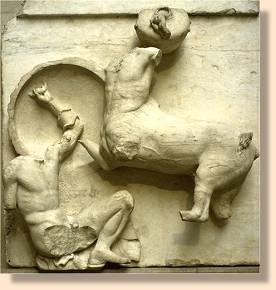|
|
|
FOR
RETURN
|
|
|
|
AGAINST
RETURN
|
|
|
|
DOCUMENTS
|
|
|
|
There can be no doubt that the British Museum is feeling the pressure of demands for the return of the Parthenon Marbles to Greece. In the past the only statement of its position was the statement printed below. More recently the British Museum has created a page on its web site which aims to answer all the points raised by its critics. The page is long and detailed. You can visit the page by clicking here. Alternatively you can read the summary of the British Museum position and correspondence printed below. The Sculptures from the Parthenon--a statement from the British Museum The Museum's collections are vested in the Trustees in accordance with the legislation enacted by Parliament, which since 1753 has prohibited them from permanently disposing of any objects (other than duplicates), and has required them to ensure that the collections are preserved for the benefit of international scholarship and the enjoyment of the general public. In fulfilment of this responsibility the Museum is open seven days a week, free of charge, and attracts more than 6 million visitors a year from all parts of the world. The sculptures from the Parthenon constitute one of the greatest and best-loved of its treasures; and the fact that they exemplify, in a unique manner, the aesthetic genius of classical antiquity, which has exerted so profound an influence on the subsequent history of mankind, makes it all the more appropriate that they should find their setting in a Museum which is universal in its scope and designed to present as complete and integrated a picture as possible of the development of different, but related, cultures through the ages. The Trustees of the British Museum would regard it as a betrayal of their trust to establish a precedent for the piecemeal dismemberment of collections which recognise no arbitrary boundaries of time or place.
Statement of the British Museum
Some questions to the British Museum We have a copy of
the British Museum statement on the Parthenon Marbles and we have some questions
as we find your statement extremely one-sided. We have a copy of
the British Museum statement on the Parthenon Marbles and we have some questions
as we find your statement extremely one-sided.
Your statement says that Lord Elgin "rescued" the Marbles, but the truth is that that they suffered priceless damage during their removal and transportation to Britain. Elgin even cut some of the sculptures in half so they could be transported more easily. Why don't you mention any of this in your statement? BribesYou also say that Elgin purchased the Marbles from the appropriate authorities. However, the evidence shows that he didn't purchase them at all. He bribed the local officials with luxurious presents.Perhaps people accepted that the Turkish Ottoman Empire was an appropriate authority in Greece at the beginning of the 19th Century. However, wouldn't you agree that today, most people do not think that an occupying country has the right to give away the national treasures of the occupied country. At the present time, for example, arguments are continuing between Germany and Russia over the return of art treasures looted by both countries from each other during the Second World War. And Turkey is in dispute with both of them over the future of the treasures from Troy, taken by Schliemann to Berlin and stolen from there by the Russians. Stolen goodsNowadays it is common for governments and monarchs to apologize for actions carried out in the past which were considered legitimate at the time. Isn't it now time for the British Museum to accept that they are guilty of receiving stolen goods and to return the Parthenon Marbles to Greece? With the state of modern technology the British Museum could make exact replicas of the Marbles to display in London and the originals could be returned to the specially built museum on the Acropolis which is planned by the Greek government.Yours faithfully,
Andri Lironi, Evyenia Lioni, Aliki Tsonga, Andreas Paragioudakis, Giorgos
Velegrakis and Vangelis Kaselouris.
. The British Museum replies...The British MuseumLondon WC1B 3DG 17 February 1997 The British Museum's statement on the sculptures from the Parthenon is naturally brief and concerns itself with the Trustees' position rather than the details of Lord Elgin's activities or the historical context. The statement does not, therefore, mention that Elgin's agents sawed off some of the backs of the frieze slabs (but without damaging any of the sculpted surfaces), just as it does not mention how the conversion of the Parthenon into a Christian church in the middle of the 5th century AD resulted in the complete destruction of the whole of the centre of the East Pediment. The Trustees' statement does not say that the sculptures were purchased by Elgin, an idea which you rightly criticise, but rather it clearly states that the collection was purchased by the British Government from Elgin, which is correct.
Finally the issue of casts and replicas is an interesting one. The British Museum has provided casts for the Greek authorities on many occasions -- the first being in 1844 when a complete set of the material in London was sent to Athens, and the latest the visit to London by a Greek restorer to make casts of the West frieze, using the type-casts that derive from Lord Elgin's moulds. This was necessary since almost the entire length of the West frieze, which remained on the Parthenon until 1993, was in such a poor state of preservation as a result of decades of industrial pollution that modern casts could not be made from it. May I wish you every success with your Internet project. Yours sincerely,
Andrew Hamilton
(Received 4 March 1997)
|